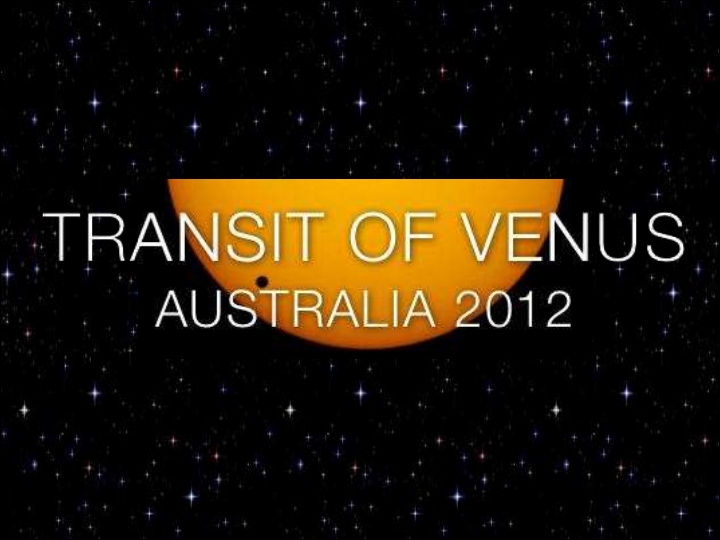



What is a Transit? ◊ A transit is when a planet passes directly between the Earth and the Sun ◊ The solar eclipse is when the Moon passes between Earth and Sun and partially to totally blocks out Sun ◊ Venus and Mercury are the only planets between Earth and the Sun so the only ones that can Transit Solar Eclipse 2004 Transit of Venus 2
3
What is the Transit of Venus? ◊ Venus passes directly between Earth and the Sun during its orbit ◊ Appears as a black disc, or silhouette moving across the Sun ◊ Takes around 6 hours ◊ Path of an upside down “U” because the Sun appears to rotate across sky 4
History of Transits ◊ Come in pairs separated by over a century ◊ Earliest recorded in 1639 ◊ 1769 Transit observed by Lieutenant James Cook Sent by Britain to Tahiti • Took measurements using • traditional Surveying, Mapping & Astronomical principles After the Transit he explored & • mapped south-east Australia ◊ 1761 and 1769 observations calculated the size of the Solar System applying Kepler’s 3 rd law of planetary motion 5
Computational analysis ◊ Spherical Trigonometry used to plot & map the Universe ◊ Astronomical Unit (AU) is used to measure the distance from Earth to the Sun ◊ Calculated by measuring how long it takes Venus to transit across the Sun ◊ Two different locations ◊ Measure distance between locations ie Latitude & longitude ◊ Time the contacts 1 & 3 6
Observing the Transit - THEN ◊ Historical observations required Surveying and Astronomy skills ◊ Surveyors used stars to help identify positions on the earth ◊ Surveying skills were needed to make maps for navigation and exploration ◊ Most explorers were also Surveyors: Captain James Cook • Matthew Flinders • Will (from Burke & Wills) • 7
What is Surveying? ◊ Surveying is the measurement & mapping of the environment ◊ Use specialised tools and equipment ◊ Principles of Maths • Geography • IT • Science • 8
Observing the Transit - NOW ◊ Modern technology now uses Global Positioning Systems (GPS), satellite remote sensing and other space-based measuring techniques. Still based on early Surveying, • Astronomy and Mathematics principles to fix positions and take measurements. Tools are faster, more economical and • provide more precise results. Specialist field called Spatial Science • 10
You will experience a rare Astronomical event ◊ Last transit was in 2004 ◊ Next Transit will happen in 2117 ◊ 6 June 2012 – the last in your lifetime 11
Observing the Transit – 2012 ◊ Never look directly at the Sun – serious damage can occur ◊ Safe viewing SolarScope • Webcast • iPhone App • ◊ Using the SolarScope iPhone App Simple but sophisticated tool • Look inside the SolarScope • View a large size projection • Take time measurements • SolarScope 12
Observing the Transit – 2012 ◊ Never look directly at the Sun – serious damage can occur ◊ Safe viewing SolarScope • Webcast • iPhone App • ◊ Using the Solarscope Simple but sophisticated tool • Look inside the Solarscope • View a large size projection • SolarScope for safe viewing 13
Acknowledgements ◊ Donated on behalf of Surveying and Spatial Science Industry, and Astronomical Association of Queensland ◊ Student education about the Transit of Venus • how Surveying was integral to early Astronomy • consider career opportunities • ◊ More information Transit of Venus: www.transitofvenus.com.au • Surveying: www.alifewithoutlimits.com.au • Spatial Science: www.destinationspatial.com.au • Sources: Surveyors & Astronomy & Future ( Peter Swan, Bob Ross, Connie Beadell, Graham Tweedie 2012) • National Aeronautics and Space Administration (NASA) • Bill Kitson (ABC Radio interview Adelaide Mar 2012) • 14
Recommend
More recommend